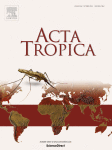View Item
- xmlui.general.dspace_homeCentros Regionales y EEAsCentro Regional Santa FeEEA RafaelaArtículos científicosxmlui.ArtifactBrowser.ItemViewer.trail
- DSpace Home
- Centros Regionales y EEAs
- Centro Regional Santa Fe
- EEA Rafaela
- Artículos científicos
- View Item
Borrelia infection in Ixodes pararicinus ticks (Acari: Ixodidae) from northwestern Argentina
Abstract
The aim of this work was to describe for the first time the presence of Borrelia burgdorferi sensu lato infecting ticks in Argentina. Unfed specimens of Ixodes pararicinus collected from vegetation in Jujuy Province were tested for Borrelia infection by PCR targeting the gene flagellin (fla), the rrfA-rrlB intergenic spacer region (IGS) and the 16S rDNA (rrs) gene. One male and one female of I. pararicinus collected in Jujuy were found to be positive to
[ver mas...]
The aim of this work was to describe for the first time the presence of Borrelia burgdorferi sensu lato infecting ticks in Argentina. Unfed specimens of Ixodes pararicinus collected from vegetation in Jujuy Province were tested for Borrelia infection by PCR targeting the gene flagellin (fla), the rrfA-rrlB intergenic spacer region (IGS) and the 16S rDNA (rrs) gene. One male and one female of I. pararicinus collected in Jujuy were found to be positive to Borrelia infection with the three molecular markers tested. Phylogenetically, the Borrelia found in I. pararicinus from Jujuy belongs to the B. burgdorferi s.l complex, and it was similar to one of the genospecies detected in I. aragaoi from Uruguay. Also, this genospecies is closely related to two genospecies known from USA, Borrelia americana and the Borrelia sp. genospecies 1. The epidemiological risk that implies the infection with Borrelia in I. paracinus ticks from Argentina appears to be low because the genospecies detected is not suspected of having clinical relevance and there are no records of Ixodes ticks biting humans in the southern cone of South America. Further studies are needed to assess accurately if there is risk of borreliosis transmitted by ticks in South America.
[Cerrar]

Author
Nava, Santiago;
Barbieri, Amália Regina Mar;
Maya, Leticia;
Colina, Rodney;
Mangold, Atilio Jose;
Labruna, Marcelo B.;
Venzal, José Manuel;
Fuente
Acta Tropica 139 : 1-4 (November 2014)
Date
2014-11
ISSN
0001-706X
Formato
pdf
Tipo de documento
artículo
Palabras Claves
Derechos de acceso
Restringido
 Excepto donde se diga explicitamente, este item se publica bajo la siguiente descripción: Creative Commons Attribution-NonCommercial-ShareAlike 2.5 Unported (CC BY-NC-SA 2.5)
Excepto donde se diga explicitamente, este item se publica bajo la siguiente descripción: Creative Commons Attribution-NonCommercial-ShareAlike 2.5 Unported (CC BY-NC-SA 2.5)

